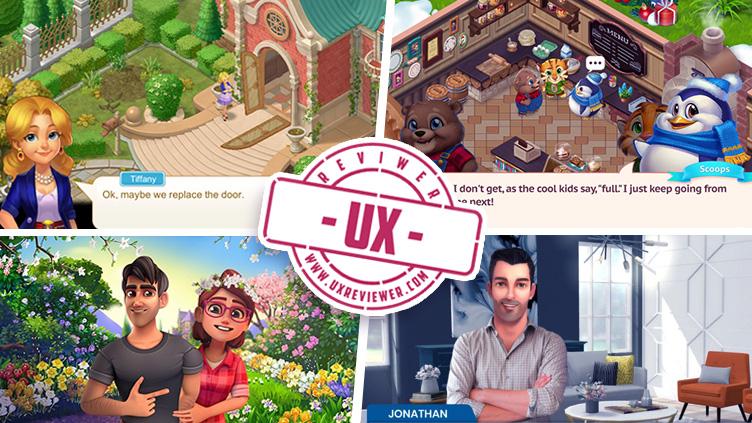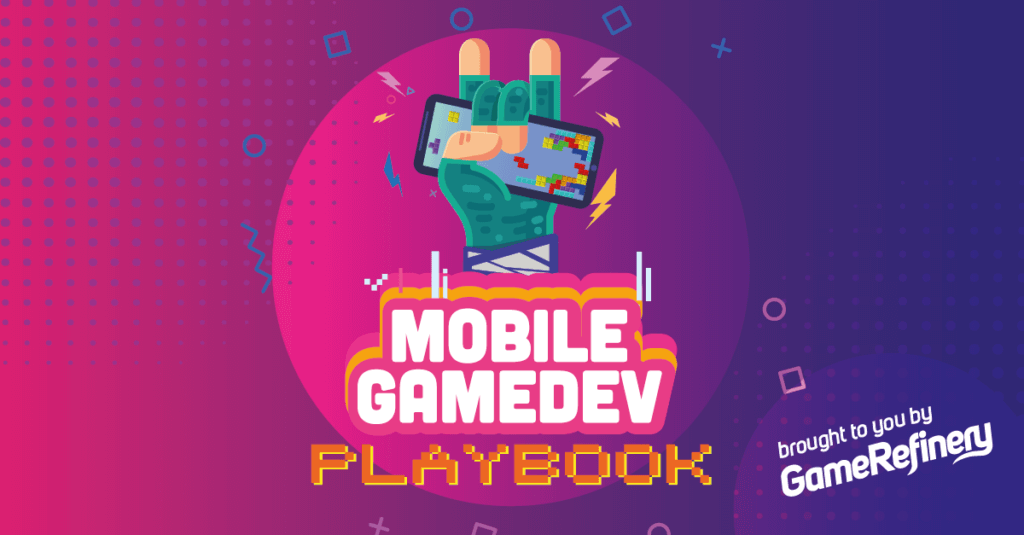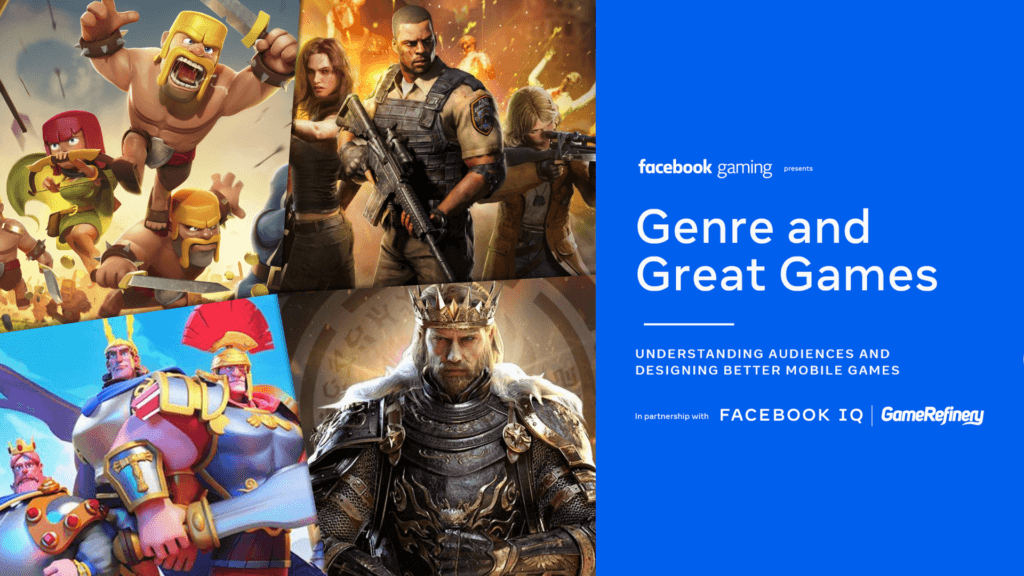How is modern-day storytelling in casual games evolving? What data & UX-driven trends are emerging in the narrative of blockbuster casual games? Let’s find out…
Editor´s note: This article is written in collaboration by Om Tandon of UXreviewer, UX Strategist and HCD practitioner in the games industry for over 15+ years, and Lisa Brunette, founder & owner of Brunette Games, a narrative design and storytelling powerhouse working with development teams at publishers and studios such as Jam City, Redemption Games, Uken Games, etc., on blockbuster top-100 grossing casual games: Sweet Escapes, Lily’s Garden, Matchington Mansion, & many others.
Size of the Pie: Casual Puzzle Games
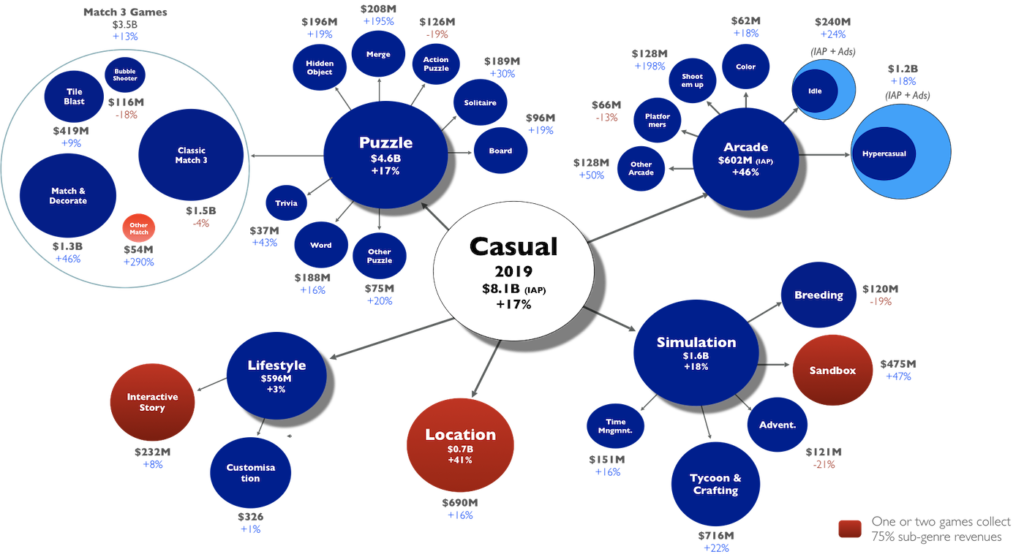
Casual games are the second-largest genre on mobile after strategy games. They generated revenue of a whopping $8.1Bn in 2019, the lion’s share of which was raked in by the Match 3 sub-genre alone.
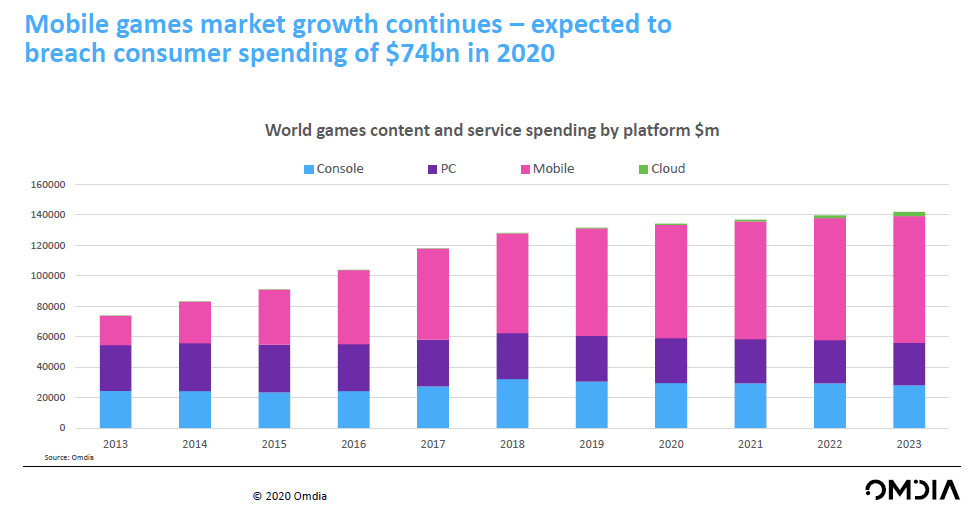
Needless to say, this figure for 2020 could be substantially higher(!) given the record-breaking performance across the industry as a byproduct of the Covid lockdowns causing a massive surge in session times and the acquisition of millions of new mobile players.
So, What’s the Story?
In the past few articles, we looked at how seemingly simple casual puzzle games, which relied heavily on just a simple core loop, have now matured due to deepening game design and maturing causal player preferences.
Genre analysis shows the following pillars appearing to be crucial for the success of any newly launched casual puzzle game today
- Core loop with variable & extensive content treadmill
- Meta loops that complement the core, decoration, base-building
- Dramatic character-driven narrative and storytelling
- Social, Guilds and Live-Ops
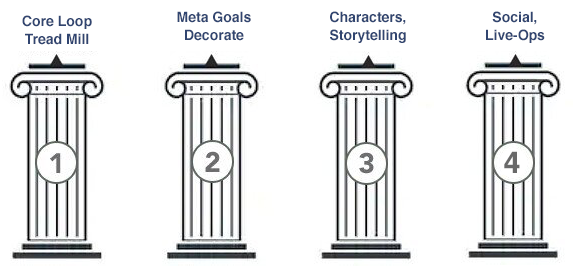
While a lot has been written about the pillars 1, 2, and 4 by the industry pundits, pillar no: 3 has not received as much scrutiny. In this article, we do exactly that by taking a deep dive with industry expert Lisa Brunette. Her studio is behind the narrative of some of the most popular meta match 3 games in the market today! But before we do that, let’s look at…
WHAT the data is telling us about the popularity of storytelling trends
Looking at historical games-industry data from GameRefinery, we can clearly see there has been an exponential rise in the success of story/narrative-driven casual puzzle games, hitting top 100 grossing, especially in the match 3 genre.
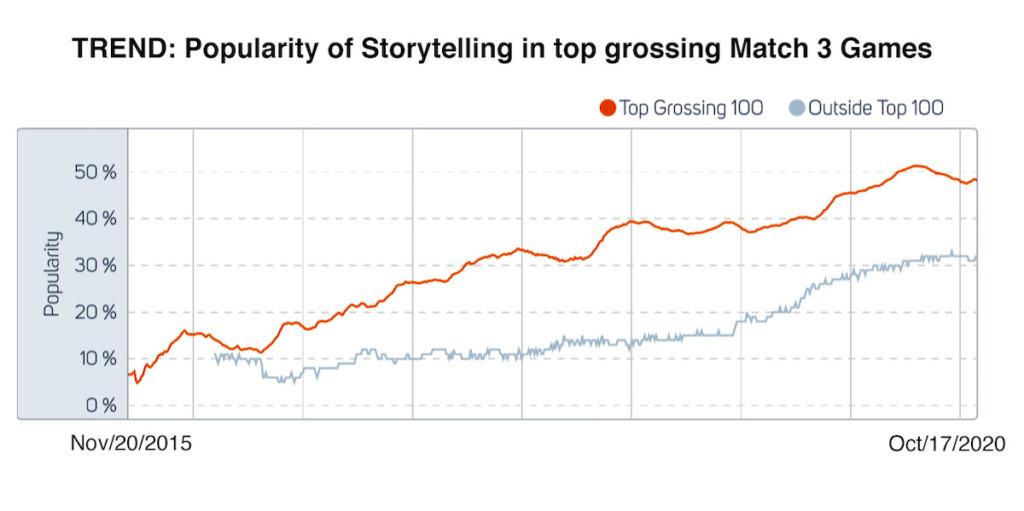
The trend data above shows that the number of new match 3 games reaching the top 100 grossing charts between 2015 and 2020 have seen an exponential rise in the incorporation of storytelling and character-driven narrative.
Which implies any new casual puzzle game breaking into top 100 grossing has a greater chance of succeeding with storytelling narrative than those that don’t.
But just knowing WHAT the trend is not good enough; let’s look at WHY storytelling trends in casual puzzle games might be on the rise?
Why storytelling might be important: Product & UX Reasons
- The puzzle game genre is fast turning into a boiling red ocean market reaching maturity, with plenty of clones and intense competition, which requires new avenues for product differentiation. Adding a layer of dramatic, character-driven storytelling might be one such avenue for creating that differentiation or finding newer audiences.
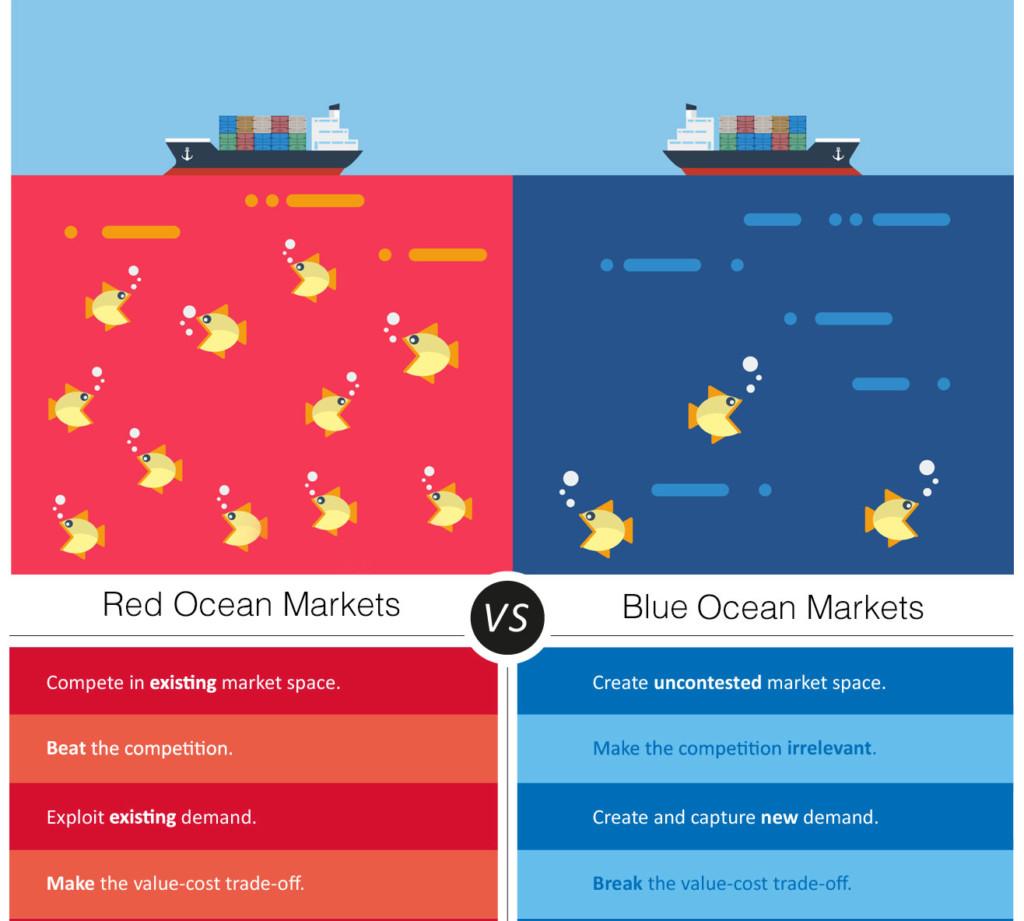
- New Emerging Player Needs: A recently published “Genre & Great Games” player insights report from Facebook Gaming and GameRefinery points out the player motivation & needs that fuel the appetite for casual games:
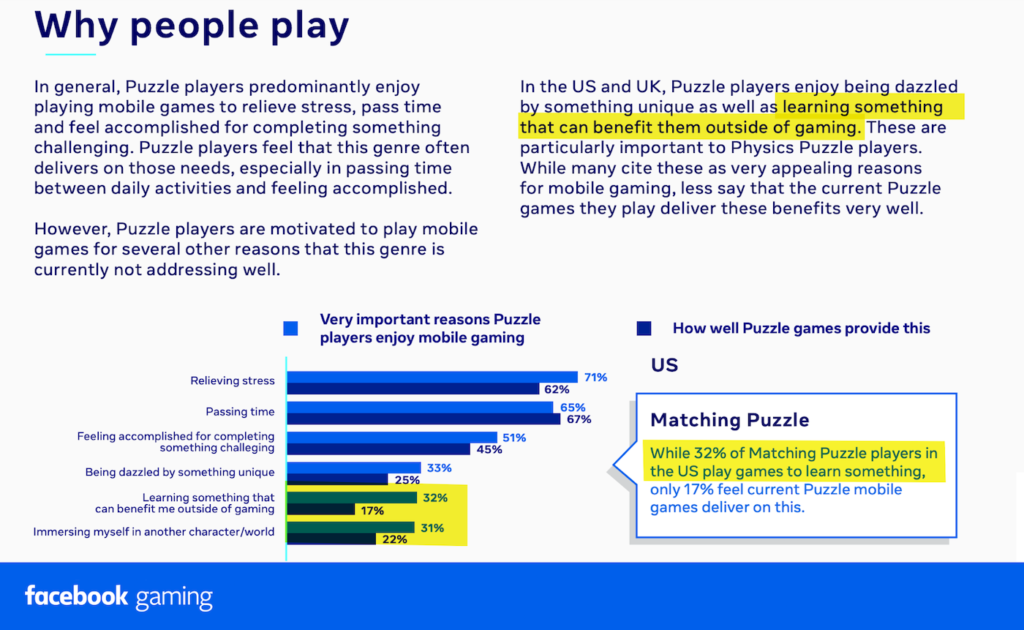
“Up to 32% of puzzle players want to learn something new that can benefit them outside games.”
Genre & Great Games Report
Above is an interesting insight into newly emerging player needs and wants! And something I actually called out in my last article, “How to Crack the Match 3 code – Part 2” (So, thanks for confirming, FB!)
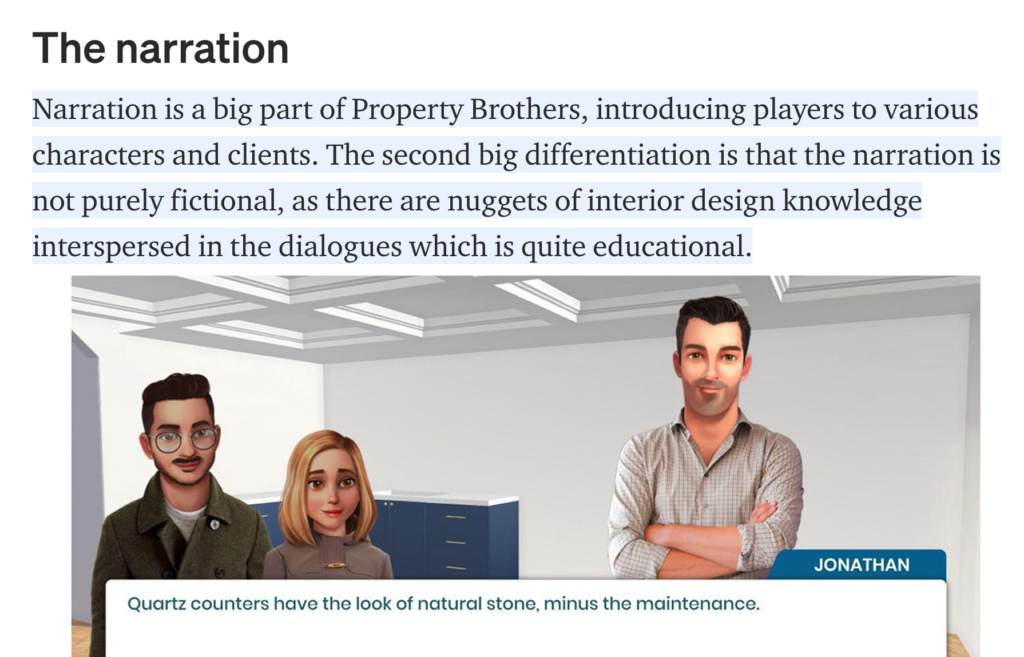
Many narrative meta-driven puzzle games not only entertain players but also educate them further into gardening, interior decorating, landscaping, etc., via character-driven narrative fulfilling a newly emerging need of learning something beneficial outside the game, too.
Notice the other closely popular need as well, that complements the need for dramatic narration and storytelling:
“Up to 31% of puzzle players want to immerse themselves in another character/world.”
Genre & Great Games Report
- Puzzle Player Diversification: Genre & Great Games, the Facebook report, also points out puzzle players are diversifying into other genres, including action & RPG.
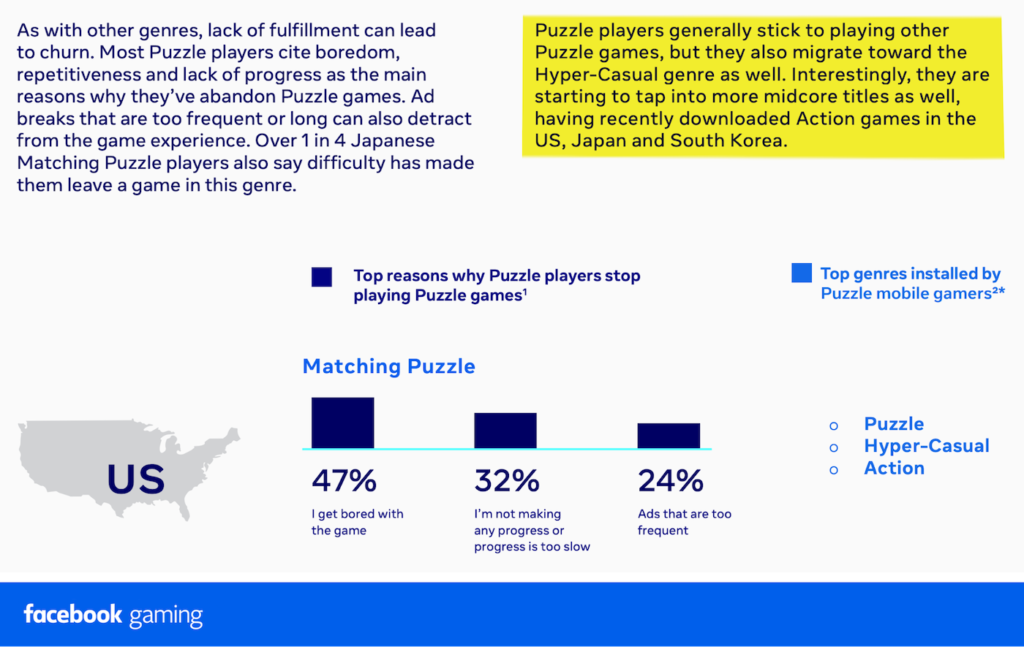
Genre diversification for casual players is something I forecasted in my previous articles 4 years ago based on the concept of player maturity. An important thing to notice is mid-core and action RPG games normally have strong character-driven narrative and storylines, which might also be exposing & gravitating casual players towards welcoming and seeking richer storytelling expectations from casual games.
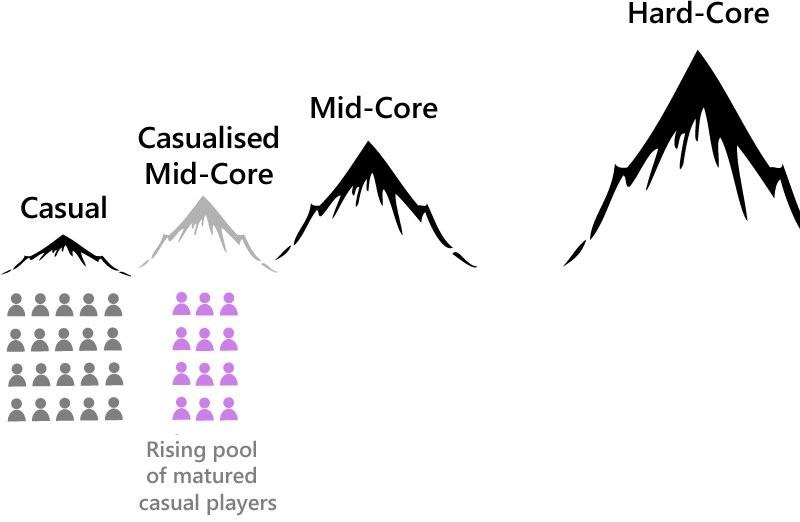
Now that we have looked at the trends and insights for the popularity of storytelling, it’s time to talk to our storytelling expert to know more about the craft of storytelling in blockbuster casual games!
Q&A with Lisa Brunette:
Om: Why is storytelling important? What draws people to stories, the narration or the characters?
Lisa: Ha, ha, I’ve actually seen game conferences that bar this question as a presentation topic because it’s considered too basic! It’s a given in most, if not all, cultures that human beings love story; our survival might actually depend on our ability to imagine characters, worlds, and plots.
I think the idea to question storytelling in games comes from the habit of conflating “story” with “text.” But adding more words to a game doesn’t automatically give it a story. We’ve played text-heavy games that are nonetheless lacking that one thing that gives the story its storyness: conflict. We’ve also played games that used only a few words to brilliantly convey conflict. For example, take a look at these two mainstream game titles and the conflict embedded in them:
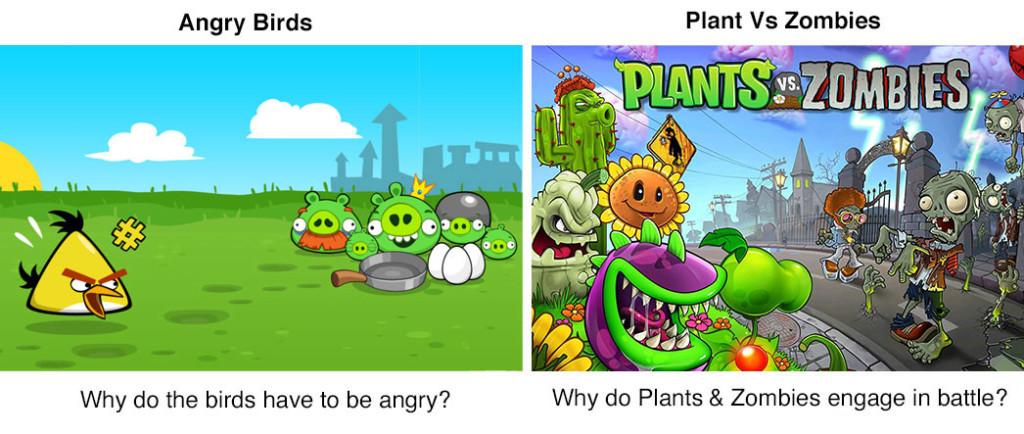
Some context: I’ve been a full-time storyteller in the game industry for about 13 years, and for all of that time, I’ve focused solely on mainstream (what we label “casual”) game development, starting out first on console games (Nintendo) and PC/Mac download (Big Fish Games) and then migrating to mobile when the industry took that turn around 2012. I’ve managed two full teams of storytellers, first at Big Fish and now as head of my own company, Brunette Games. So why or whether storytelling is important seems like a foregone conclusion to me.
We’re living in an age in which “binge-watching” is part of our lexicon. It’s not the set design that keeps people up late at night, unable to quit Netflix. It’s the story.
Lisa talking about why storytelling is important.
Om: Is modern day storytelling in mobile games different? (From console games or television)
Lisa: Storytelling for film/TV, books, or any other non-interactive medium is very different from all game storytelling because they don’t have at their core a game to consider. For example, in Disney Frozen Adventures, the player’s primary interaction is to redecorate rooms in the castle or shops in Frozen’s fictitious town of Arendelle. So the story must revolve around, support, and provide motivation for that activity.

We’re often writing in tandem not just with a redecorating interaction but with the match-3 puzzle that also drives the game. That’s where we work with art teams to create tie-ins that reference the narrative, whether that’s in the design of the match-3 tiles or the surrounding art, the presence and actions of a helper character, or the power-ups, etc.
These elements might seem obvious now, but back in 2017, when I proposed reworking the tiles in the first level of Matchington Mansion to resemble pillows to link narratively with the throw pillows Tiffany adds to the living room, it was seen as a radical idea!
Lisa on working with art teams to create tie-ins that reference the narrative.
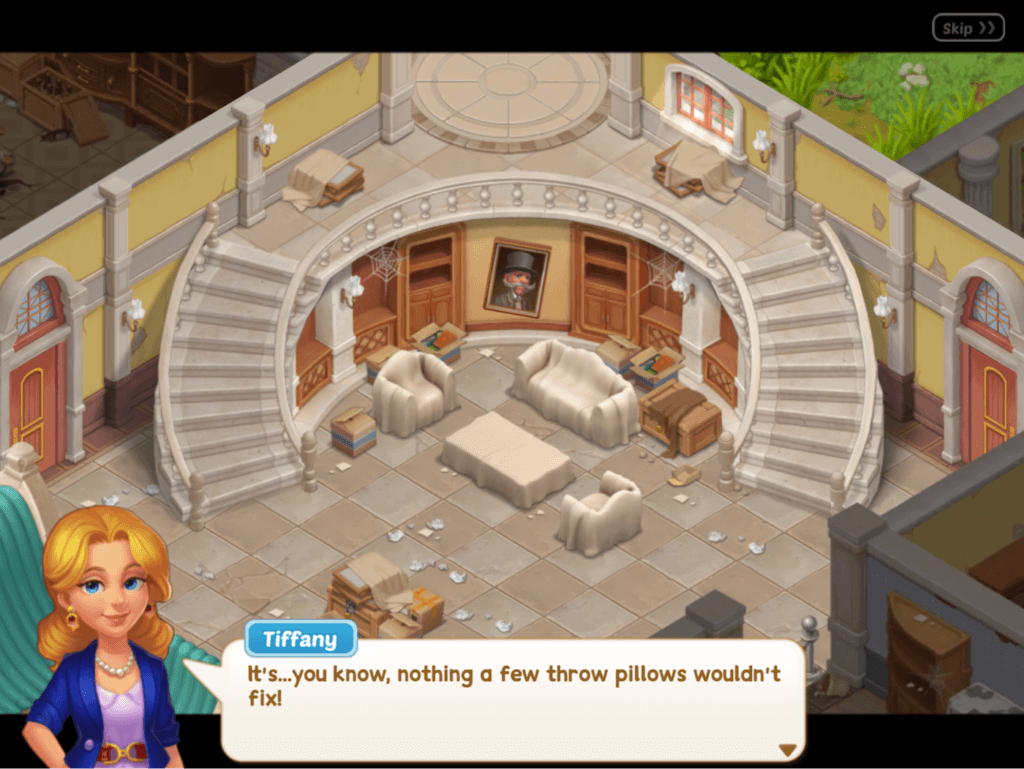
You asked about the differences between console and mobile games in your question above, but I’m not the person to compare those two platforms. My best comparison is actually between PC/Mac download and mobile. And there’s something worth noting in the differences between the two.
Personally, I have yet to see the dark, edgy content in casual mobile games that was a regular feature of the hundreds of hidden-object puzzle adventure (HOPA) games I worked on at Big Fish back in 2011-2016. Those games had me on the edge of my seat, and the jump scares, at least in one case, actually made me jump––in the middle of a cubicle pod at work. While the HOPAs I worked on 4-5 years ago were at times dark enough to require a warning label even though they were still casual fare, most narrative on mobile today falls squarely in the cheery camp.
We think there’s a missed opportunity for much edgier content.
Lisa on using dark, edgy content in casual mobile games.
Darker-themed games are still being released, warning labels and all, but sadly, the mystery/thriller genre––which is incredibly popular in all other mainstream media––hasn’t really been embraced by casual mobile developers. Here’s a scene from Mystery Case Files: Ravenhearst Unlocked.
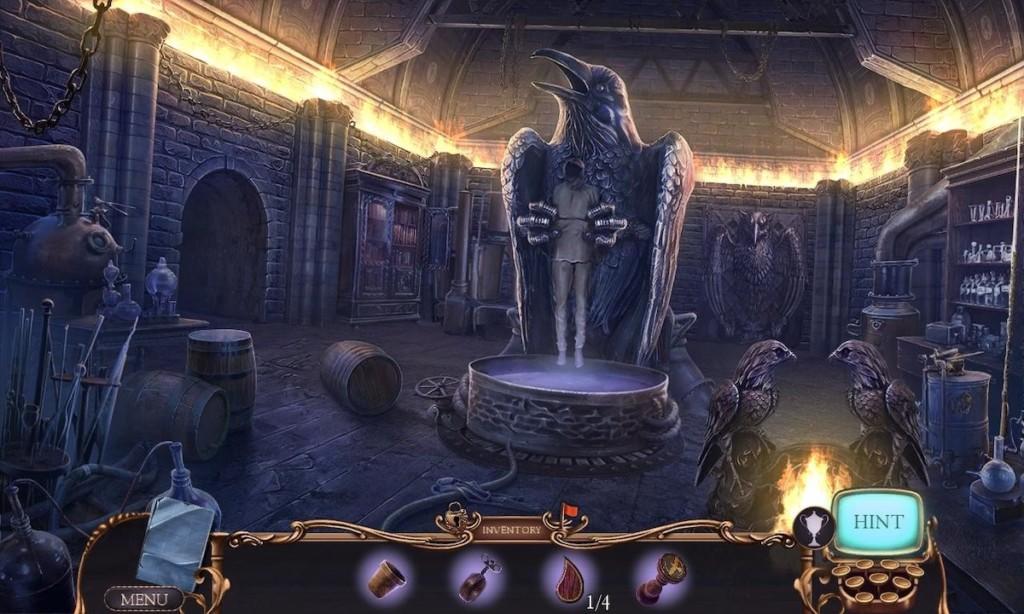
Does it matter that we’re playing on the phone now instead of PC? I don’t think so. While designers often come to us because they want to compete with top-performing puzzle games, we think the real competition lies elsewhere––on Netflix, Amazon Prime, HBO… Our whole Brunette Games team is glued to The Haunting of Bly Manor right now, for example. Just as your interview with Playrix in part 2 in this series revealed that those designers went back to previous-era casual games for inspiration that paid off, I believe we’ll do the same when it comes to narrative.
Om: What in your opinion makes story-led, top-grossing games so popular?
Lisa: It’s like the old saying goes: Trying to design a major hit game is like trying to capture lightning in a bottle. If there were one sure formula, everyone would have a hit, right? While many ingredients make a game popular with players––from a well-designed match-3 puzzle to the right blend of customization and progression pacing in the decorating element––it’s our opinion at Brunette Games that a quality story is key.
With so many match-3 games on the market, and so many decorating games as well, story could be one of the key distinguishing factors you have at your disposal.
Lisa on how to differentiate in the Match 3 genre.
When Tiffany burst onto the scene in 2017 to fight Rex Houston and save your mansion, all we had leading the category was Candy Crush. When Tactile gave players a love triangle in Lily’s Garden, especially amping the meter with provocative viral ads, it showed the romance genre could be pushed much further. And players have responded.

Om: What are the trends you foresee in most successful projects you have taken up to date?
Lisa: The trend is very much toward more sophisticated storytelling, which means a deeper complexity in characters and plots, but that doesn’t mean more text in games or less gameplay. On the contrary, new gameplay mechanics like merge puzzles and new narrative hybrids with other types of gameplay, such as solitaire, are showing that narrative blends with core gameplay in multiple ways in this space. We’ll look for mobile game storytelling to move out of adolescence and into adulthood, in a lot of ways.
One offering we’ve added to our suite of services at Brunette Games is voice-over. It fits well with our mission because as writers of the dialogue scripts to be voiced, we’re the best people on the team to give direction to the voice actors.
Lisa talking about future trends in casual mobile games.
More of our clients are using voice-overs, and not just in the intro cutscene but throughout the game. We’ll likely see more of this in the future.
We’re also excited to work with clients who want to crack the interactive novel format, which has had so far a limited success, and with relatively narrow audience segments. Branching dialogue is another tough nut to crack.
Om: What advice will you give to game developers looking to create story-driven gameplay?
Lisa: In a genre that has maintained its light-and-bright feel for so long, in the absence of dark and edgy, one area where we’ve made great strides is in the humor genre. It’s paid off in spades on Sweet Escapes, a title we write for Redemption Games.
We took a cue from the irreverent humor they built into the game’s character design and animations, and our team has matched it with hilarious dialogue, to the point where players have actually written fan fiction based on the characters.
Lisa talking about using humor in storytelling in Sweet Escapes.
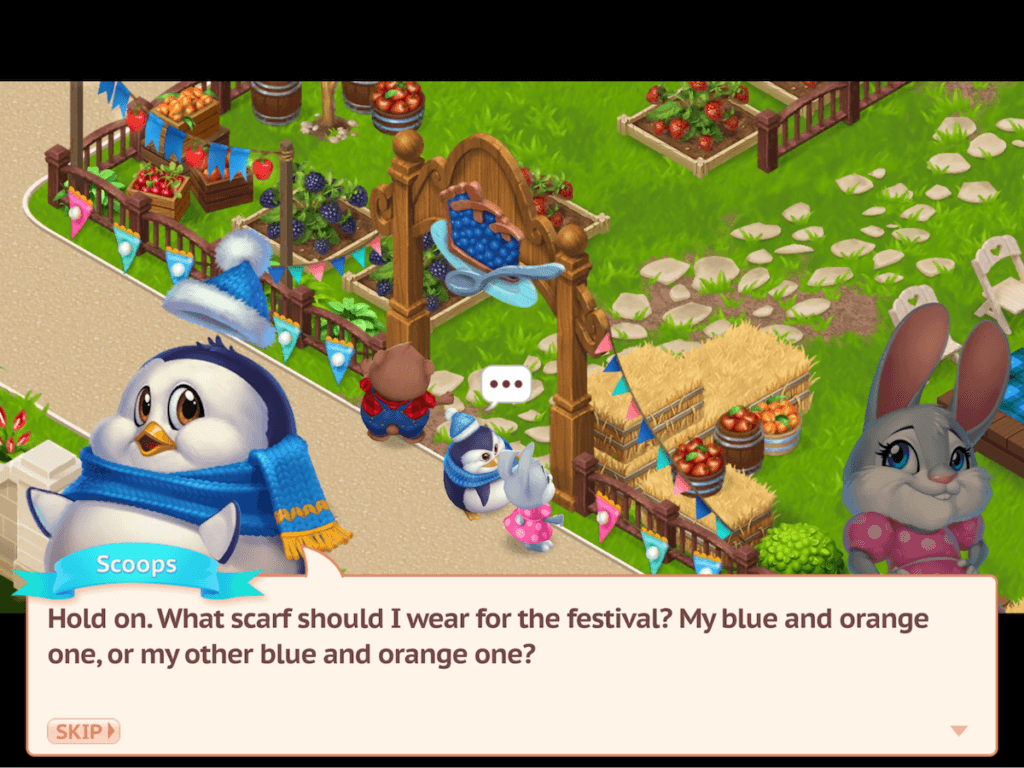
Humor is hard to write, so you really want to invest in top-notch wordsmiths if you go this route.
Beyond that, I would say this: Bring narrative in at the very beginning, at the concept stage. Too many times, we’ve been invited to join a project too late, so that our work becomes largely triage. The other thing we’ve seen a lot is studios skimping on the writing budget at first, hiring an inexperienced person who can actually do a lot of damage in a short amount of time. Then they end up spending again to have us come in and fix it.
Om: Any other wrap-up comments?
Lisa: I’ll just add that as a studio devoted 100 percent to storytelling, we’ve had a rather unique, bird’s-eye view on how narrative is progressing in this space. It’s been a privilege to work with a broad cross-section of talented teams on so many different projects. It’s gratifying to see how much everyone cares about narrative––from C-level leadership to game designers to artists, animators, and voice-over artists. It truly takes a team to create a great game story!
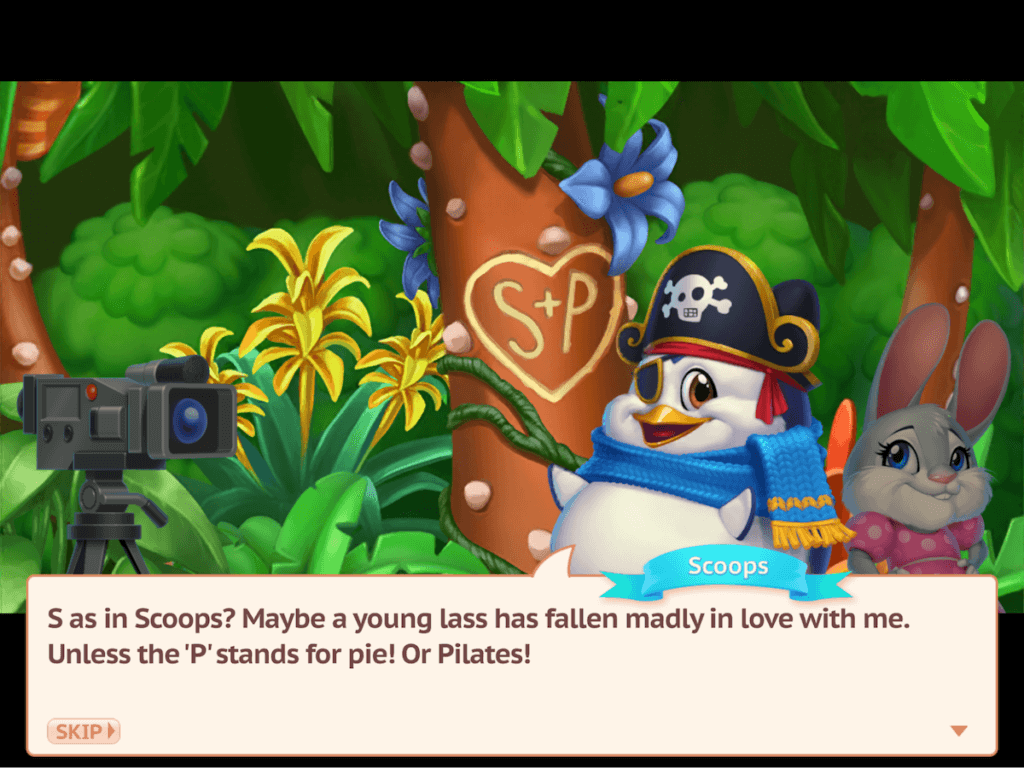
Conclusion: Modern-day storytelling trends and insights
- There is an exponentially upwards trend in the success of story/narrative-driven casual puzzle games, hitting top 100 grossing, especially in the match 3 genre over the last 4 years. This implies that new casual puzzle games trying to break into the top 100 grossing have a greater chance of succeeding with strong storytelling.
- The casual puzzle games genre is fast maturing into a crowded red ocean market place. Product differentiation via immersive storytelling and bonding with players via niche themes is one way to stand out from the crowd and even attract new audiences.
- New player needs and wants are emerging in this space, with around 32% of all casual puzzle players saying they “Want to learn something new that can benefit them outside gaming,” and close to 31% play to “Immerse themselves in another character/world.” Both of these needs can be met via educational narrative and rich storytelling.
- Most narrative on mobile today falls squarely in the cheery camp, and there might be a missed opportunity for edgier fare. Either way, some degree of conflict needs to be at the heart of the narrative for it to constitute a “story.”
- The story cannot stand alone from the game. The narrative and the character need to blend in with the core gameplay loop, for example, tying the characters and plot to the decorating activity and the match-3 or collapse mechanic.
- The use of character voice-overs is gaining more traction amongst games; this trend might see more adoption in the future.
- Differentiation can come within the narrative-driven competition through quality comedic dialogue, or exploration of themes at the edge of casual gaming, such as the mystery/thriller genre, or even horror.
If you liked this post, please feel free to check out Om Tandon’s other game deconstructs at https://www.uxreviewer.com/. Feel free to connect with Om here for future articles.

